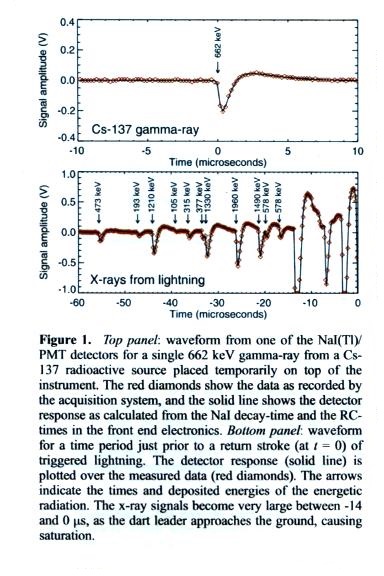Dwyer
et al. (2003) observed bursts of energetic radiation at the
end of the dart leader and possibly right at the start of the
return stroke in 31 out of 37 triggered events studied (recall
that the return strokes in triggered discharges are thought to be
comparable to subsequent return strokes in natural cloud-to-ground
discharges but that there is not a 1st return stroke in a
triggered flash). The bursts lasted less than 100 μs.
My understanding is that sensor used during this 2002 field
experiment was unable to distinguish between energetic electrons,
X-rays, and gamma rays in this initial study.
An improved sensor was used during the summer 2003 campaign
and Dwyer
et al. (2004) report X-rays were measured 0 to 80 μs prior
to and at the beginning of 73% of return strokes studied.
Each X-ray burst usually lasted less than 1 μs. The most
intense bursts come from parts of the channel that is within 50 m
of the ground.

Note the increase is X-ray signal
amplitudes as the leader approached the ground. The
return stroke began at t = 0 in the figure.
Dwyer
et al. (2005) has measured X-ray emissions coming from
the stepped leader process in natural cloud to ground
discharges.
The last 11 steps of the stepped leader are
shown.
Implications
Emissions from dart leaders in triggered lightning and
stepped leaders in natural lightning are similar. This
suggests some similarities in the discharge process (dart
leaders may actually step
Observations may provide some clues about leader propagation
processes.
The standard "relativistic runaway electron avalanche model"
might have some trouble trying to explain the lightning
generated X-ray emissions.
And finally something that appeared in the local
newspaper yesterday




